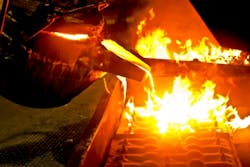TimkenSteel Cited After Worker Death
Normal oxygen levels in the atmosphere are between 20 to 21 percent, but when another gas such as nitrogen is introduced, levels are depleted which could lead to oxygen-deficiency in confined or closed spaces and subsequently to death, as in the recent case of Canton, Ohio-based TimkenSteel.
The alloy steel bar and tubing manufacturer recently was the subject of an OSHA investigation after a March 20 indicent in which a worker was found dead in the elevator control room while performing monthly fire extinguisher checks. An investigation determined nitrogen leaked into the control room resulting in an oxygen deficient atmosphere causing the worker's death.
OSHA’s Cleveland Area Office cited the steel mill for two repeated and four serious safety violations following two separate agency investigations at the TimkenSteel's Canton plant.
"As a result of the fatality, the company discontinued the use of nitrogen to power tools and removed all the connections from the ventilation systems," said Howard Eberts, OSHA's Cleveland area director in a statement. "TimkenSteel has made significant strides in fixing safety discrepancies and improving the framework of the safety and health management system in its aging plants in recent months. These two investigations demonstrate that maintaining a safe working environment requires a commitment to continuous improvement."
OSHA cited the company for failing to protect workers from potentially hazardous atmospheres created by the introduction of nitrogen into the ventilation system and failing to train workers to use pneumatic tools powered by nitrogen on the hazards, effects and how to detect nitrogen leakage.
A separate March investigation, before the employee’s death, found multiple fall hazards including exposing workers to fall hazards of up to 20 feet while performing maintenance in the rolling mill and failing to install guardrails on walkways.
The proposed penalty amount for the violations totals $113,131.
The company signed a settlement agreement in August 2016 to abate hazards cited by OSHA at its Ohio steel plants in 2015, including multiple violations of fall protections standards.
Under terms of the agreement, TimkenSteel will implement numerous enhancements such as a STOP work card program, an anonymous safety reporting system, create a United Steel Workers safety position at three facilities, retain an abatement auditor, create an electronic tracking of corrections, and conduct routine safety audits for fall hazards and lockout/tagout procedures.
Both TimkenSteel and United Steelworkers did not provide comment at the time of publication.
